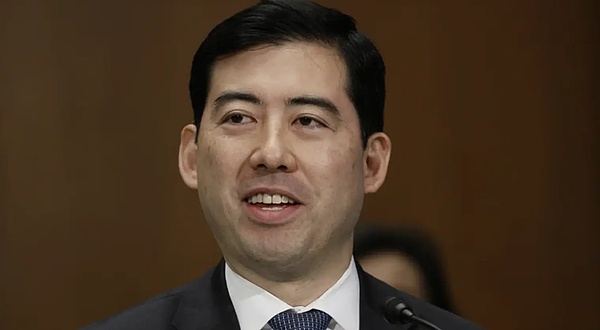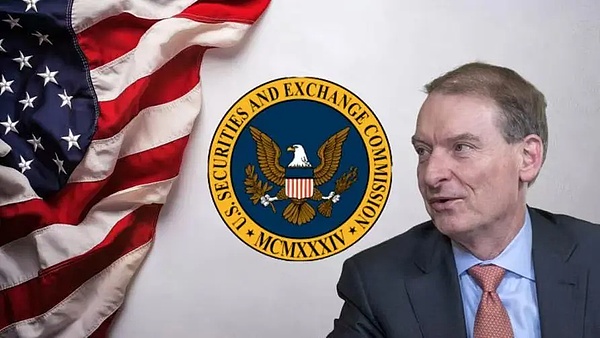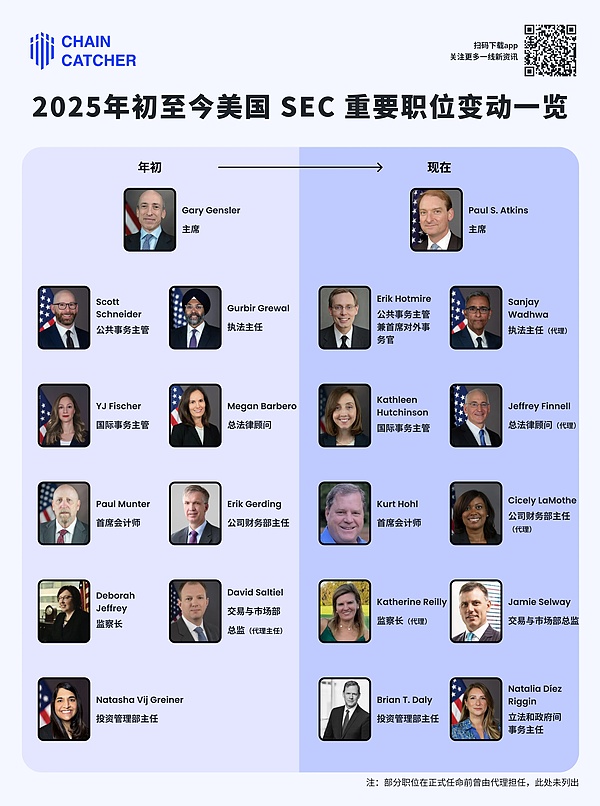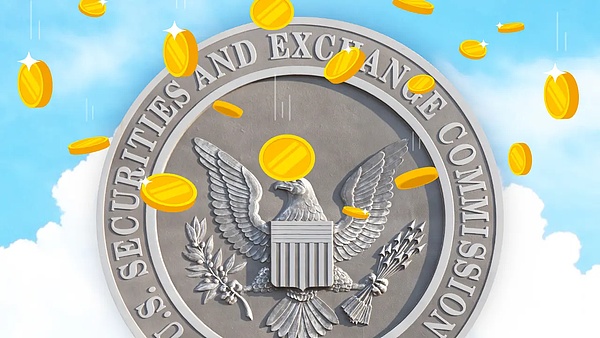Author: Fairy, ChainCatcher
Editor: TB, ChainCatcher
Within half a year, several key executives were replaced, more than 500 people resigned, and departments were restructured... The U.S. Securities and Exchange Commission experienced drastic adjustments in the first half of 2025.
This internal storm is quietly reshaping the regulatory landscape of the crypto market. This article will review the key changes in the SEC over the past six months and analyze whether the "new" SEC has truly opened a friendly door to cryptocurrencies.
Three changes in chairmanship, "tuning" the rhythm of crypto regulation
In the first half of 2025, the U.S. Securities and Exchange Commission (SEC) experienced the replacement of three chairmen: Gary Gensler during the Biden administration, Acting Chairman Mark T. Uyeda, and current Chairman Paul Atkins. Unlike Gensler, who has a tough stance and frequently initiates law enforcement actions, both Uyeda and Atkins are considered to be more friendly to the crypto industry. Acting Chairman Mark T. Uyeda has always been open to crypto, and he once cast a key vote in favor of the Bitcoin spot ETF. In just a few months as an agent, Uyeda quickly implemented the Trump administration's pro-crypto commitments: establishing a "Cryptocurrency Task Force" led by Hester Peirce; revoking the much-criticized SAB 121 accounting policy; and establishing the "Cyber and Emerging Technology Unit (CETU)" to replace the old "Crypto Assets and Network Department."

In April 2025, Paul Atkins officially took over as chairman of the SEC, further consolidating this shift in attitude. Atkins is no stranger to the crypto community: as early as 2017, he served as co-chairman of the Digital Chamber of Commerce Token Alliance, actively promoting the formulation of industry standards for token issuance and trading. According to Fortune, Atkins holds about $6 million worth of crypto-related assets, involving shares or other investments in crypto companies such as Anchorage and Securitize.
After taking office, Atkins has publicly expressed a crypto-friendly stance many times. He pointed out that "the crypto market has been trapped in the SEC's regulatory gray area for many years" and promised to "return to the fundamental mission of promoting rather than suppressing innovation" during his term.

Major changes in core departments
In addition to the change of chairman, the core departments of the SEC also ushered in a number of key personnel adjustments. The following are important position changes at the SEC from the beginning of the year to date:

Among the 10 executives who have changed, at least two new executives are considered to have experience in the crypto industry: Brian T. Daly, director of the investment management department, and Jamie Selway, director of the trading and market department.
Brian T. Daly was previously a partner at the international law firm Akin Gump. In his official resume, digital assets, cryptocurrencies and blockchain are listed as areas of expertise; and Jamie Selway was a partner at Sophron Advisors and served as global head of institutional markets for crypto company Blockchain from 2018 to 2019. More importantly, the two departments they are in charge of are extremely important in the SEC structure. The Investment Management Department is responsible for regulating investment products and services including mutual funds, ETFs, closed-end funds and registered investment advisors. The Trading and Markets Department controls the operating rules of market infrastructure such as exchanges, market makers, brokers, and clearing houses. In other words, crypto ETFs and the crypto trading environment are affected by these two departments. At the same time, the SEC's enforcement department, a key "power center", has also completed a blood transfusion. Gurbir Grewal, the former director of the Enforcement Department, who has long been tough on encryption, left office in October 2024. During his tenure, he led a number of heavyweight encryption lawsuits including Ripple and Coinbase. According to Cornerstone Research data, in 2024, the SEC initiated a total of 33 encryption-related enforcement actions involving 90 defendants or respondents.
After Grewal left, Sanjay Wadhwa took over as acting director, and the enforcement efforts have slowed down significantly. Between February and March this year, the SEC withdrew its lawsuits against several well-known crypto companies, including Coinbase, Consensys, Robinhood, Gemini, Uniswap and Kraken.
In addition, the SEC launched an employee "buyout plan" at the end of February, offering $50,000 in compensation to employees who voluntarily resigned. In the end, more than 500 people chose to retire early or resign, accounting for about 10% of the total number of employees in the institution. This wave of "internal slimming" also created space for subsequent structural reorganization and policy shifts.
Has the SEC's "crypto rhythm" changed?
In terms of regulatory trends, the SEC is making intensive meetings and policy statements. In the first half of this year, the SEC has held six crypto-related roundtables, covering core topics such as regulatory frameworks, custody mechanisms, asset tokenization, and DeFi.
At the regulatory level, it is also taking steps. On May 30, the SEC issued a policy statement on PoS network staking activities, clarifying for the first time that three types of staking behaviors do not constitute securities issuance: including user self-staking, non-custodial third-party staking, and compliant custodial staking. This provides a clearer compliance path for current crypto staking services.
At the same time, ETF approval has begun to accelerate. On June 11, the SEC issued a notice to several institutions that intend to issue Solana spot ETFs, requiring them to resubmit a revised S-1 document within 7 days and promised to complete the review feedback within 30 days after submission.

There are personnel changes, loosening of rules, and softening of attitudes. This organization, which has made countless crypto projects "walk on thin ice", is re-dialogue with the industry.
Regulation will not disappear, but future regulation may no longer be a high-pressure network, but a bridge to co-construction.
 Alex
Alex
 Alex
Alex Jasper
Jasper Aaron
Aaron Jixu
Jixu Joy
Joy Clement
Clement Davin
Davin YouQuan
YouQuan Hui Xin
Hui Xin Joy
Joy